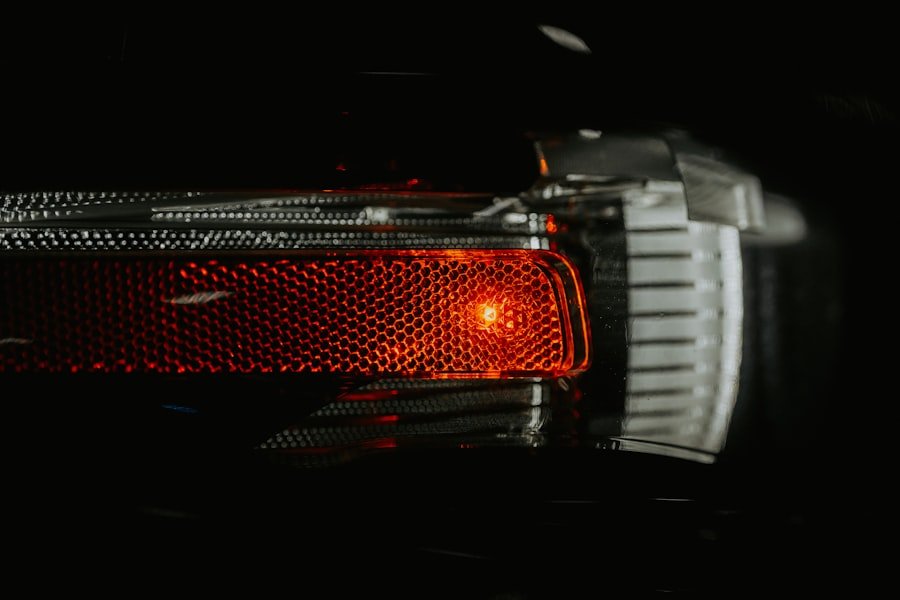Headlight flickering is a phenomenon that can be both alarming and perplexing for drivers. When headlights flicker, it can create a sense of unease, not only for the driver but also for other road users.
Understanding the underlying causes of headlight flickering is essential for ensuring safety on the road and maintaining the functionality of a vehicle’s lighting system. The flickering of headlights can manifest in various ways, from a subtle dimming to a rapid on-and-off cycle. This inconsistency in lighting can be indicative of several issues, ranging from minor electrical glitches to more serious mechanical failures.
As vehicles become increasingly reliant on complex electrical systems, recognizing the signs of headlight flickering and addressing them promptly is crucial for both safety and vehicle longevity.
Key Takeaways
- Headlight flickering is a common issue that can be caused by a variety of factors, including electrical issues, environmental factors, and mechanical problems.
- Common causes of headlight flickering include loose wiring, a faulty alternator, and voltage fluctuations.
- Electrical issues such as loose connections, corroded terminals, and a weak battery can contribute to headlight flickering.
- Environmental factors like extreme temperatures, moisture, and road vibrations can also lead to headlight flickering.
- Mechanical problems such as a failing voltage regulator or a damaged headlight assembly can cause headlight flickering.
Common Causes of Headlight Flickering
There are numerous reasons why headlights may flicker, and identifying the root cause is essential for effective troubleshooting. One of the most common culprits is a faulty connection within the electrical system. Loose or corroded wiring can disrupt the flow of electricity to the headlights, leading to intermittent illumination.
This issue is often exacerbated by vibrations from driving, which can further loosen connections over time. Another frequent cause of headlight flickering is a failing alternator. The alternator is responsible for charging the vehicle’s battery and supplying power to the electrical systems while the engine is running.
In some cases, a weak battery can also contribute to this problem, as it may not hold a charge effectively, leading to inconsistent power delivery.
Electrical Issues

Delving deeper into electrical issues, one must consider the role of fuses and relays in the headlight circuit. A blown fuse can interrupt the power supply to the headlights, causing them to flicker or fail entirely. Similarly, a malfunctioning relay may not properly engage or disengage, leading to erratic behavior in the headlights.
These components are often overlooked during routine maintenance but play a critical role in ensuring stable headlight operation. Moreover, the quality of the bulbs themselves can also impact headlight performance. Halogen bulbs, for instance, are known to have a limited lifespan and may flicker as they near the end of their operational life.
LED headlights, while generally more reliable, can also experience flickering if there are compatibility issues with the vehicle’s electrical system or if they are improperly installed. Understanding these nuances is vital for diagnosing and resolving headlight flickering issues effectively.
Environmental Factors
| Factor | Measurement |
|---|---|
| Air Quality | PM2.5 levels |
| Water Quality | PH levels |
| Temperature | Degree Celsius |
| Biodiversity | Species count |
Environmental factors can also play a significant role in headlight flickering. For instance, extreme temperatures can affect the performance of electrical components. Cold weather can cause battery performance to decline, while excessive heat can lead to overheating of electrical connections and components.
Moisture intrusion is another environmental concern; water or humidity can corrode connections and lead to short circuits, resulting in flickering headlights. Additionally, road conditions can contribute to headlight issues. Driving on rough terrain or poorly maintained roads can subject a vehicle’s electrical system to vibrations that may loosen connections or damage wiring.
In urban environments, where streetlights and other vehicles create varying light conditions, drivers may perceive flickering more acutely as they navigate through these changing environments.
Mechanical Problems
Mechanical problems can also be at the heart of headlight flickering issues. One potential mechanical cause is a misaligned headlight assembly. If the headlights are not properly aligned, they may appear to flicker as they struggle to maintain a consistent beam pattern.
This misalignment can occur due to impacts from potholes or accidents that jolt the vehicle’s structure. Another mechanical issue that could lead to flickering headlights is a failing ignition switch. The ignition switch controls power distribution throughout the vehicle’s electrical system, including the headlights.
If this switch is worn or damaged, it may not provide a stable connection, leading to intermittent power loss and flickering lights. Regular inspections of mechanical components are essential for identifying such issues before they escalate into more significant problems.
How to Diagnose Headlight Flickering

Diagnosing headlight flickering requires a systematic approach to identify the underlying cause accurately. The first step is to conduct a visual inspection of the headlight bulbs and wiring harnesses. Look for signs of damage, such as frayed wires or burnt-out bulbs.
If any issues are found, replacing the damaged components may resolve the flickering. Next, testing the battery and alternator is crucial. A multimeter can be used to measure voltage output from the alternator while the engine is running; it should typically read between 13.5 and 14.5 volts.
If the reading falls outside this range, it may indicate an alternator issue that needs addressing. Additionally, checking battery terminals for corrosion and ensuring they are tightly connected can help eliminate potential power delivery problems.
Preventing Headlight Flickering
Preventing headlight flickering involves regular maintenance and proactive measures to ensure all components of the vehicle’s electrical system are functioning optimally. Routine inspections of wiring harnesses and connections can help identify potential issues before they lead to flickering lights. Keeping connections clean and free from corrosion will enhance conductivity and reduce the likelihood of electrical failures.
Furthermore, investing in high-quality replacement bulbs can also mitigate flickering issues. While cheaper bulbs may seem appealing, they often lack durability and reliability compared to premium options. Additionally, ensuring that all electrical components are compatible with each other—especially when upgrading to LED or HID systems—can prevent compatibility-related flickering problems.
Conclusion and Final Thoughts
Headlight flickering is more than just an annoyance; it can pose significant safety risks on the road if left unaddressed. By understanding the various causes—ranging from electrical issues and environmental factors to mechanical problems—drivers can take informed steps toward diagnosing and resolving these issues effectively. Regular maintenance and proactive measures play a crucial role in preventing flickering headlights and ensuring that vehicles remain safe and reliable on the road.
In summary, being vigilant about headlight performance and addressing any signs of flickering promptly will not only enhance visibility but also contribute to overall road safety for all users. Whether through routine inspections or timely repairs, taking action against headlight flickering is an essential aspect of responsible vehicle ownership.
If you are experiencing issues with your headlights flickering, it may be due to a variety of reasons such as a faulty alternator or loose wiring. To ensure your vehicle’s electrical system is functioning properly, it is important to address this issue promptly. For more tips on maintaining your vehicle’s electrical components, check out this article on 5 High-Quality Table Protectors That Are Heat-Resistant.
FAQs
What are the common causes of headlights flickering?
Common causes of headlights flickering include a loose or corroded headlight bulb connection, a failing alternator, a weak battery, or a faulty headlight switch.
How does a loose or corroded headlight bulb connection cause flickering?
A loose or corroded headlight bulb connection can cause flickering because it disrupts the flow of electricity to the bulb, resulting in intermittent power supply and flickering.
What role does the alternator play in causing headlights to flicker?
The alternator is responsible for charging the battery and providing power to the electrical system. If the alternator is failing, it may not be able to provide a consistent power supply to the headlights, causing them to flicker.
How does a weak battery contribute to headlights flickering?
A weak battery may not be able to provide a stable power supply to the headlights, especially during periods of high electrical demand, leading to flickering.
Can a faulty headlight switch cause headlights to flicker?
Yes, a faulty headlight switch can cause headlights to flicker because it may not be able to maintain a consistent connection, resulting in intermittent power supply to the headlights.

